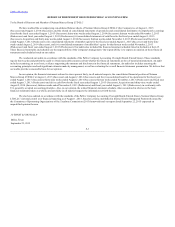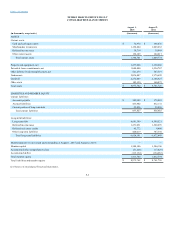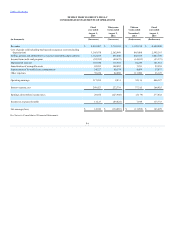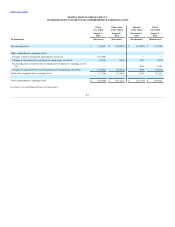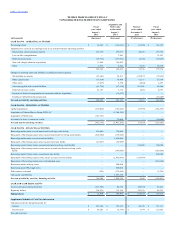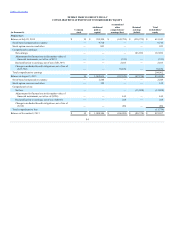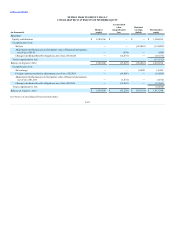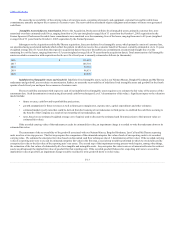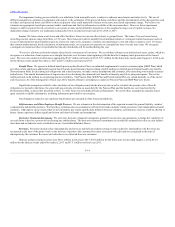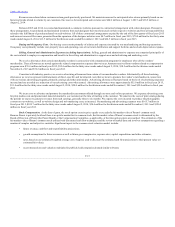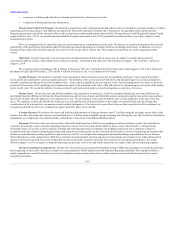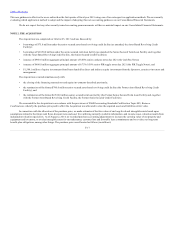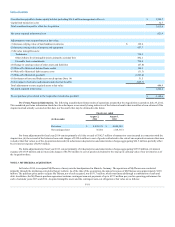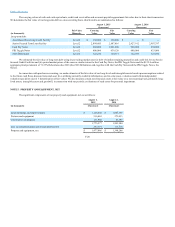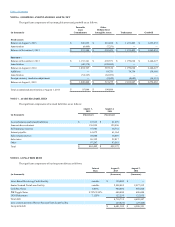Neiman Marcus 2014 Annual Report Download - page 114
Download and view the complete annual report
Please find page 114 of the 2014 Neiman Marcus annual report below. You can navigate through the pages in the report by either clicking on the pages listed below, or by using the keyword search tool below to find specific information within the annual report.
Table of Contents
accounting purposes as of November 2, 2013, the end of our first quarter of fiscal year 2014. The MyTheresa acquisition and the allocation of the purchase
price were recorded for accounting purposes as of November 1, 2014, the end of our first quarter of fiscal year 2015. In connection with the allocations of the
purchase price, we made estimates of the fair values of our long-lived and intangible assets based upon assumptions related to the future cash flows, discount
rates and asset lives utilizing currently available information, and in some cases, valuation results from independent valuation specialists, which resulted in
increases in the carrying value of our property and equipment and inventory, the revaluation of intangible assets for our tradenames, customer lists and
favorable lease commitments, the revaluation of our long-term benefit plan obligations and, with respect to the MyTheresa acquisition, the recording of our
contingent earn-out obligation at estimated fair value, among other things.
Cash and Cash Equivalents. Cash and cash equivalents primarily consist of cash on hand in our stores, deposits with banks and overnight
investments with banks and financial institutions. Cash equivalents are stated at cost, which approximates fair value. Our cash management system provides
for the reimbursement of all major bank disbursement accounts on a daily basis. Accounts payable includes outstanding checks not yet presented for payment
of $57.3 million at August 1, 2015 and $45.6 million at August 2, 2014.
Merchandise Inventories and Cost of Goods Sold. We utilize the retail inventory method of accounting. Under the retail inventory method, the
valuation of inventories at cost and the resulting gross margins are determined by applying a calculated cost-to-retail ratio, for various groupings of similar
items, to the retail value of our inventories. The cost of the inventory reflected on the Consolidated Financial Statements is decreased by charges to cost of
goods sold at average cost and the retail value of the inventory is lowered through the use of markdowns. Earnings are negatively impacted when
merchandise is marked down. As we adjust the retail value of our inventories through the use of markdowns to reflect market conditions, our merchandise
inventories are stated at the lower of cost or market.
The areas requiring significant management judgment related to the valuation of our inventories include (i) setting the original retail value for the
merchandise held for sale, (ii) recognizing merchandise for which the customer’s perception of value has declined and appropriately marking the retail value
of the merchandise down to the perceived value and (iii) estimating the shrinkage that has occurred between physical inventory counts. These judgments and
estimates, coupled with the averaging processes within the retail method can, under certain circumstances, produce varying financial results. Factors that can
lead to different financial results include (i) determination of original retail values for merchandise held for sale, (ii) identification of declines in perceived
value of inventories and processing the appropriate retail value markdowns and (iii) overly optimistic or conservative estimation of shrinkage. In prior years,
we have not made material changes to our estimates of shrinkage or markdown requirements on inventories held as of the end of our fiscal years.
Consistent with industry business practice, we receive allowances from certain of our vendors in support of the merchandise we purchase for resale.
Certain allowances are received to reimburse us for markdowns taken or to support the gross margins that we earn in connection with the sales of the vendor’s
merchandise. These allowances result in an increase to gross margin when we earn the allowances and they are approved by the vendor. Other allowances we
receive represent reductions to the amounts we pay to acquire the merchandise. These allowances reduce the cost of the acquired merchandise and are
recognized at the time the goods are sold. The amounts of vendor allowances we receive fluctuate based on the level of markdowns taken and did not have a
significant impact on the year-over-year change in gross margin during fiscal years 2015, 2014 or 2013. We received vendor allowances of $94.8 million in
fiscal year 2015, $88.5 million for the thirty-nine weeks ended August 2, 2014, $5.0 million for the thirteen weeks ended November 2, 2013 and $90.2
million in fiscal year 2013.
We obtain certain merchandise, primarily precious jewelry, on a consignment basis to expand our product assortment. Consignment merchandise
held by us with a cost basis of $399.0 million at August 1, 2015 and $376.8 million at August 2, 2014 is not reflected in our Consolidated Balance Sheets.
Cost of goods sold also includes delivery charges we pay to third party carriers and other costs related to the fulfillment of customer orders not
delivered at the point-of-sale.
Long-lived Assets. Property and equipment are stated at cost less accumulated depreciation. In connection with the Acquisition, the cost basis of the
acquired property and equipment was adjusted to its estimated fair value. For financial reporting purposes, we compute depreciation principally using the
straight-line method over the estimated useful lives of the assets. Buildings and improvements are depreciated over five to 30 years while fixtures and
equipment are depreciated over three to 15 years. Leasehold improvements are amortized over the shorter of the asset life or the lease term (which may
include renewal periods when exercise of the renewal option is at our discretion and exercise of the renewal option is considered reasonably assured). Costs
incurred for the development of internal computer software are capitalized and amortized using the straight-line method over three to ten years.
F-12


